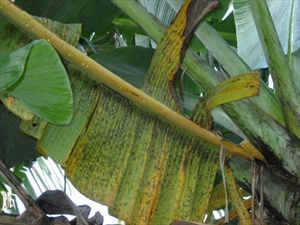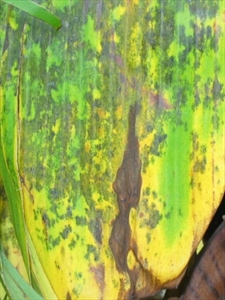Banana speckle, banana leaf speckle, tropical speckle, common speckle. Note, a disease known as 'fruit speckle' also exists.
Pacific Pests, Pathogens, Weeds & Pesticides - Online edition
Pacific Pests, Pathogens, Weeds & Pesticides
Banana leaf speckle (308)
Metulocladosporiella musae (previous names are Cladosporium musae, and Periconiella sapientumicola), Ramichloridium biverticillatum (Periconiella musae), Ramichloridium musae (Periconiella musae, Veronaea musae), and Mycosphaerella musae are all referred to a 'leaf speckle'. Ramichloridium species are also said to cause 'tropical speckle'1. Mycosphaerella musae is called 'common speckle'. Colletotrichum musae and Fusarium species cause 'fruit speckle' in Australia.
Ramichloridium biverticillatum. Leaf speckle (also tropical speckle). Tropics, including Africa and Southeast Asia, Oceania. Common in Pacific island countries: American Samoa, Australia (species not known), Federated States of Micronesia, Fiji, French Polynesia, Palau, Papua New Guinea, Samoa, Solomon Islands, and Vanuatu.
Ramichloridium musae. Leaf speckle (also tropical speckle). Widespread in banana growing areas of the world. Asia, Africa, South and Central America, West India, Oceania. It is recorded from many Pacific island countries: American Samoa, Australia (species not known), Cook Islands, Federated States of Micronesia, Fiji, Palau, Papua New Guinea, Samoa, Solomon Islands, Tonga, and Vanuatu.
Metulocladosporiella musae. Leaf speckle. Widespread in tropics and sub-tropics where bananas are grown, including Southeast Asia, Africa, Central and South America, the Caribbean, Oceania. It is recorded from French Polynesia, Papua New Guinea, Samoa, Solomon Islands, and Vanuatu. In Central America, Metulocladosporiella musae is frequently present with Ramichloridium speckle.
Mycosphaerella musae. Leaf speckle (common speckle). Africa, Central America, and a narrow distribution in Oceania. It is recorded from Australia, Cook Islands, Federated States of Micronesia, Marshall Islands, Palau, and Solomon Islands.
Colletotrichum musae and Fusarium species cause fruit speckle in Australia.
Banana (commonly Cavendish variety), plantain.
Ramichloridium biverticillatum. Leaf speckle (also tropical speckle). Diffuse irregular or circular, grey, brown or black blotches, up to 5 cm diameter, especially on underside of older leaves (Photo 1). Similar symptoms also occur on leaf and fruit stalks. Spread is by airborne spores.
Ramichloridium musae. Leaf speckle (also tropical speckle). There are several descriptions: In Solomon Islands (as Ramichloridium biverticillatum),"diffuse irregular or circular, grey, brown or black blotches, especially on the underside of the leaf on older leaves". In Fiji1 (as Cloridium musae = Ramichloridium musae), "Leaves are covered with small, evenly spread aggregations of black spots that are individually the size of a pinhead. On the older leaves the dots may merge to form blotches". In Australia, "Tropical speckle appears on young foliage as tan coloured circular blotches up to 5 cm diameter on the underside of the leaf (Photo 2). Similar symptoms are also found on leaf midribs and fruit stalks2". Spores are produced on the underside of the leaves, and are spread occurs in wind and rain. In Fiji, the disease is favoured by shade, close planting, cool weather and very high rainfall.
Metulocladosporiella musae. Leaf speckle. One of several fungi causing leaf speckle, and leaf spots. Sometimes, centred on black cross (Phyllachora musicola) infections (see Fact Sheet no. 71). Leaf spots first visible as pale greenish flecks, ellipsoid to oblong, forming streaks up to 2 cm long, pale to blackish brown, turning orange or dark brown, merging and forming large patches, occasionally somewhat target-like. Spread is by airborne spores.
Mycosphaerella musae. Leaf speckle (also common speckle). Light brown irregular blotches on the lower surface of the leaf, darkening to dark purple to black (Photos 3&4), and becoming visible on both leaf surfaces. May coalesce to give large bleached necrotic areas (Photo 4). Present only on leaves five and six and older before flowering. When infection is severe, there is a loss of leaves and bunches are small, and ripening is uneven. Spread occurs by spores blown in the wind from small black fruiting bodies on old leaves; spores grow on the surface of leaves before infections occur, and because of this infection occurs mainly on the shaded underside.
Colletotrichum musae and Fusarium species. Reddish-brown to black spots, 0.5 to 1 mm diameter, often seen more at the flower end of the fruit (Photo 5). The spots give the fruit a raised or bumpy feel when there are many of them. Spread occurs as spores from infection on dead flowers, fruit bracts, and leaves during wet weather.
In general, speckle diseases are only of minor importance, and are unlikely to reduce yield. The exception is Mycosphaerella musae, which can be serious in commercial plantings if not controlled, resulting in loss of leaves, and poor fruit yield.
Look for diffuse irregular or circular grey, brown or black blotches, especially on the underside of the older leaves. Metulocladosporiella musae is somewhat different: look for small spots that elongate into grey or light brown streaks, similar to early symptoms of black Sigatoka (see Fact Sheet no. 2).
CULTURAL CONTROL
Before planting
- Reduce plant density to lower leaf infection.
During growth:
- Collect, remove and destroy heavily speckled leaves from plants, as well as trash - old leaves which are likely to contain spores of Mycospheaerella musae.
- Remove shade and weeds to keep humidity as low as practical around the plants.
- Desucker plants according to established methods; this reduces humidity around the main plant, as well as produced well-formed bunches..
CHEMICAL CONTROL
Mostly, speckle diseases are not of economic importance. The fungicides used to control black Sigatoka will reduce speckle, including Mycosphaerella musae, which is possibly the most important of the speckle-causing fungi. Fungicides are only recommended for commercial plantations; examples are:
(i) Protectant fungicides (these stay on the surface of plants) -
- Mancozeb.
- Copper hydroxide.
- Chlorothalonil.
- Banana misting oil.
Mancozeb can be used together with oil or an oil/water emulsion; chlorothalonil is used in water. If black Sigatoka was not present, these would be sufficient to control speckle diseases. If black Sigatoka was present, then systemic fungicides might be used.
(ii) Systemic fungicides (these move inside the plants) -
- Triazoles (e.g, propiconazole, fenbuconazole and tebuconazole).
- Strobilurins (e.g., azoxystrobin).
If systemic fungicides are use, it is important to rotate the fungicides in the different groups to prevent the build-up of resistant strains of the fungus. No more than two applications of the same systemic fungicide should be made before changing to another group. In drier times, mancozeb can be used alone. Note, it is important to add a sticker to any of the fungicides.
____________________
When using a pesticide, always wear protective clothing and follow the instructions on the product label, such as dosage, timing of application, and pre-harvest interval. Recommendations will vary with the crop and system of cultivation. Expert advice on the most appropriate pesticides to use should always be sought from local agricultural authorities.
AUTHORS Grahame Jackson & Eric McKenzie
1Information from Graham KM (1971) Plant diseases of Fiji. Her Majesty's Stationery Office. London; and (including Photos 2-5) 2Diseases of fruit crops in Australia (2009). Editors, Tony Cooke, et al. CSIRO Publishing; and from (including Photo 1) McKenzie E (2013) Ramichloridium biverticillatum: PaDIL - (http://www.padil.gov.au).
Produced with support from the Australian Centre for International Agricultural Research under project PC/2010/090: Strengthening integrated crop management research in the Pacific Islands in support of sustainable intensification of high-value crop production, implemented by the University of Queensland and the Secretariat of the Pacific Community.








